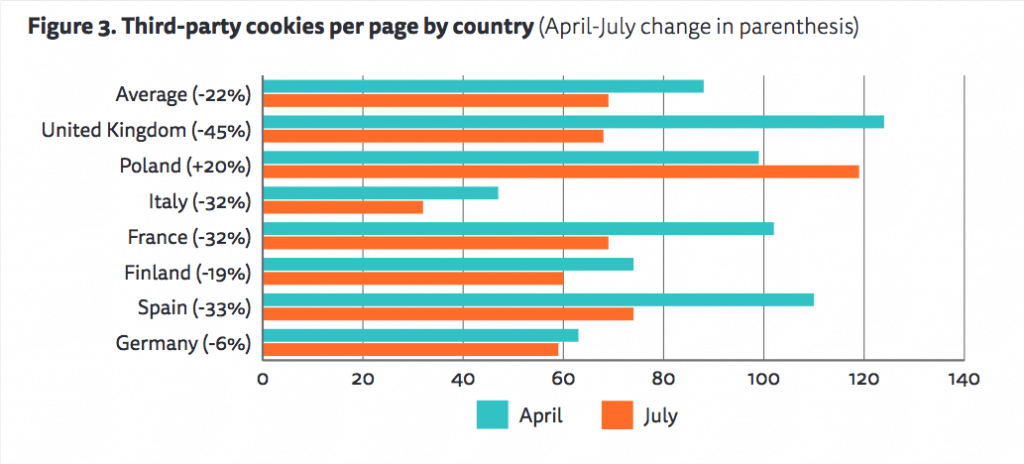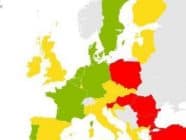
© Wikimedia
The volume of third-party content across Europe’s news sites has significantly decreased since the introduction of the EU General Data Protection Regulation (GDPR) on May 25 2018, new research by the Reuters Institute for the Study of Journalism has found.
The research, based on a comparison of third-party content on news sites in April and July 2018 – before and after the introduction of GDPR – records a 22% drop in the number of cookies set without user consent; a nine per cent decrease in third-party social media cookies; and a seven per cent drop in the number of news sites that host third-party social media content, such as sharing buttons from Facebook or Twitter.
However the analysis of homepages from over 200 of Europe’s most prominent news sites recorded little change in the overall percentage of pages from news providers which contain some form of third-party content (99%) or third-party cookies (98%).
Number Of Third-Party Cookies Dropped
The number of third-party cookies per page dropped by 22% across all news sites. German news sites, which had the second-lowest number of cookies in April, exhibit the smallest change with 6% fewer cookies. UK news sites, which had the most cookies per page in April, had 45% fewer by July.
The percentage of news sites hosting third-party social media content, such as sharing buttons from Facebook or Twitter, dropped significantly, from 84% in April to 77% in July.
Decreases in third-party cookies between April and July vary by the type of content setting the cookie. Across our sample, on average, the number of cookies from design optimisation tools is down 27%, advertising and marketing cookies down 14%, and social media cookies down 9%.
The US-based technology companies remain present on the highest number of the news sites in our sample, Google (96%), Facebook (70%), and Amazon (57%); of these, only Facebook has seen a significant drop in reach after GDPR (down five percentage points). But most of the other companies with the widest presence in April, including Verizon and Oracle in the US, WPP in the UK and Criteo in France, have seen significant drops in their post-GDPR reach, in many cases of ten percentage points or more.

Bad News For Ad-Tech Companies
One of the authors of the report, Rasmus Kleis Nielsen, said the results are significant: “News sites, especially those based on advertising, are particularly dependent on third parties for many critical features ranging from monetisation to social sharing, and thus the question of how they deal with GDPR is both important and indicative of wider response. We find a clear decline in volume of third-party content, but also interesting that – with the partial exception of Facebook – the biggest “losers” in terms of reach have been ad-tech companies outside the top three – not the biggest US-based tech firms.”
The impact of GDPR is best viewed as an ongoing process rather than a singular event.
The report’s lead author, Timothy Libert, said it is not yet possible to say with certainty why the changes observed in the research have occurred and some shifts may be unrelated to GDPR. However, he added: “in many cases third-party cookies should not have been set without consent prior to GDPR, so the changes we see may be more reflective of adjustments in compliance strategies than the new regulatory requirements.”
He went on to say that “while the outlook for user privacy appears to be improving, it is too early to know how transparent opt-in notices are, what portion of users elect to allow third-party cookies, and how many websites force users to accept third-party tracking to view content. Overall, the impact of GDPR is best viewed as an ongoing process rather than a singular event, and while May 25 has come and gone, our initial data suggests we may continue to see change on the European web.”
The factsheet, Changes in Third-Party Content on European News Websites after GDPR, by Timothy Libert, Lucas Graves and Rasmus Kleis Nielsen, builds on an earlier report, Third-Party Web Content on EU News Sites: Potential Challenges and Paths to Privacy Improvement, which compared third-party content on news sites with other popular websites during the first three months of 2018. This revealed that news websites tend to have dramatically higher volumes of third-party content and cookies than other popular websites.
The full report is available here.
If you liked this story you might also be interested in All the News That’s Fit For GDPR Compliance.
Sign up for the EJO’s regular monthly newsletter or follow us on Facebook and Twitter.
Tags: Ads, Advertising, Cookies, Data protection, Eu, European Union, GDPR, General Data Protection Regulation, Google Analytics, Media outlets, news organisations, Personalisation, privacy, Publisher, Reuters Institute for the Study of Journalism, RISJ, Targeting, Third-party cookies













































